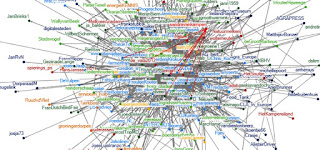I've been on a surprise strip. You book a trip for three day but without having a clear where you are going to. Very exciting! We had to be at Schiphol by 5 am and although we were still sleepy: the taxi driver was not. He talked a lot, probably to stay awake .... He was very enthusiastic about a new system with data in his taxi. His story reminded me occasionally of an episode of Black Mirror: Nosedive with a society based upon likes. Everyone gives each other points/likes and you need to have a certain number of points to be able to live somewhere in a certain appartement. It does not work out well for the hero of the story.
Your data are always indicators, such as the number of minutes hands off the wheel. It was clear that people are always trying to outdo the system. For example, a taxi driver can turn on the radio 5 times in succession for 30 seconds and in between put his hands on the wheel to avoid a lower score. The question is whether that is safer than changing the radio at once. So know what you are actually measuring and ways users may tweak the system. You should never just look at the figures and forget to use your common sense.
By the way our surprise trip took us to Rome!
The wonderful taxi system
The fantastic system of our taxi driver consists of a point system (it is called cicada) adopted by his taxi company. Every driver earns points with his or her driving style. At first, he first did not care about his score, until it turned out that a female colleague scored highest. Knowing this, stimulated him to want to improve his score. Our driver was already at 98. For a long time his scores remained at 96 and he thought you could never get 100, but ... by keeping his hands on the wheel he was able to increase his score. I asked him what you have to do as a taxi drive to score this high. It comes down to riding evenly, not accelerate or brake suddenly, but also keep your hands on the wheel for example. He knew exactly how many seconds he could be on the radio before his score went down. It became interesting when a training place was released to become an executive driver. Our (black) driver was not nominated. Then someone thought about the scores, and wondered whether the scores should be an indication. Since our driver had the highest score he earned the place in the training and became an executive taxi driver.From taxi to learning analytics
Clive Shepherd discussed the new skillset that L&D-ers need to develop. One of the new skills is interacting with media, and that includes the use of data. L&D also has to deal with new data which are available because of working with online media. Just think of the data you collect in your LMS or during a webinar. Although I was on vacation, I could not help myself to think about the parallels between the taxi system and learning analytics. With learning analytics you use data to gain insight into how people learn and how to support learning. The taxi data are aimed at a better driving style. The positive thing about the points system is that our driver was not nominated for the training, but because of his points he could prove that he was the best. Could you also provide a more objective assessment using learning analytics? For example, looking for the real experts? What also worked really well is the gamification element. He wanted to get a high score and therefore changed his driving style. Tip is therefore to make learning analytics understandable for learners themselves.People always tweak the system
One more thing: you have to pay attention to what you measure with your system / learning analytics. Know what you are measuring. Combine it with observations. In the black mirror episode the system has very bad effects because people are going to judge each other. So be aware of the effect on people. Who wins, who looses?Your data are always indicators, such as the number of minutes hands off the wheel. It was clear that people are always trying to outdo the system. For example, a taxi driver can turn on the radio 5 times in succession for 30 seconds and in between put his hands on the wheel to avoid a lower score. The question is whether that is safer than changing the radio at once. So know what you are actually measuring and ways users may tweak the system. You should never just look at the figures and forget to use your common sense.
By the way our surprise trip took us to Rome!


